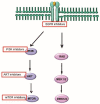HPV Positive Head and Neck Cancers: Molecular Pathogenesis and Evolving Treatment Strategies
- PMID: 27043631
- PMCID: PMC4846850
- DOI: 10.3390/cancers8040041
HPV Positive Head and Neck Cancers: Molecular Pathogenesis and Evolving Treatment Strategies
Abstract
Head and neck squamous cell carcinoma (HNSCC) is a highly heterogeneous disease that is the result of tobacco and/or alcohol abuse or infection with high-risk Human papillomaviruses. Despite the fact that HPV positive HNSCC cancers form a distinct clinical entity with better treatment outcome, all HNSCC are currently treated uniformly with the same treatment modality. At present, biologic basis of these different outcomes and their therapeutic influence are areas of intense investigation. In this review, we will summarize the molecular basis for this different outcome, novel treatment opportunities and possible biomarkers for HPV positive HNSCC. In particular, the focus will be on several molecular targeted strategies that can improve the chemoradiation response by influencing DNA repair mechanisms.
Keywords: HPV; head and neck cancer; molecular pathogenesis; radiation therapy.
Figures
References
Publication types
LinkOut - more resources
Full Text Sources
Other Literature Sources




